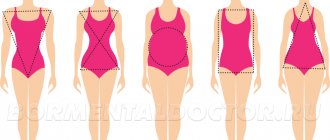Mifflin-san Geor's formula - daily calorie intake
The Mifflin–San Geor formula was introduced in 2005. Developed by nutritionists from the USA. It got its name from the names of the group leaders.
It is recognized as the most accurate for calculating calorie intake. According to the American Dietetic Association, the error is no more than 10%.
The algorithm counts the number of calories, taking into account individual characteristics: weight, height, age, gender.
The formula has two options: basic calculation and additional.
Mifflin-san Geor's Basic Formula
The basic formula calculates the daily calorie intake to maintain life in a state of complete rest.
The calculation is based on your basal metabolic rate. In other words: basic (basal) metabolic rate - Basal Metabolic Rate (BMR).
Male BMR = (weight in kg ×10) + (height in cm × 6.25) - (age × 5) + 5. Female BMR = (weight in kg ×10) + (height in cm × 6.25) - (age × 5) – 161
Additional calorie calculation
A person does not sit in one place. Any movement entails additional calorie consumption. Therefore, coefficient “A” was added to the Mifflin-san Geor formula - the activity coefficient.
How to use the Mifflin formula calculator?
It's quite simple. Enter your weight, height, age, select gender and your level of physical activity. Depending on whether you are a woman or a man, the calculation will be carried out using one of the formulas, since the calculation method is different for different genders. Why is described below.
The value that is obtained is the estimated number of kilocalories that must be consumed in one day to maintain body weight constant, assuming that it remains at rest. The formula includes an activity factor D (typically between 1.2 and 1.9) based on a person's typical exercise levels. It is needed in order to get a more realistic estimate for maintaining body weight, since we are mostly not in a calm state throughout the day.
How to calculate daily calorie intake
Let's look at an example. Let's take the basic Mifflin-san Geor formula to calculate calorie intake per day.
Let's imagine a man and a woman with the same parameters: weight 70 kg, height 170 cm, age 30 years.
To maintain life in a state of complete rest, a man needs 1617.5 kcal, a woman – 1451.5.
The difference is explained by the fact that women have a slower metabolism.
How to calculate calorie intake based on physical activity
In the Mifflin-san Geor formula, coefficient “A” has five values.
1.2 – minimal physical activity. Sedentary work.
1.375 – low level of physical activity. Do exercises two to three times a week for 20 minutes.
1.55 – normal level of physical activity. Daily exercises and walks.
1.7 – intense work or physical activity. Heavy physical work or full training at least five times a week.
1.9 – level of a professional athlete.
How to calculate calorie intake for men
For men, the daily calorie intake, taking into account the activity coefficient, is as follows.
((weight ×10) + (height × 6.25) - (age × 5) + 5) × A.
That is, the basic caloric expenditure is multiplied by the activity coefficient. Let's return to the examples.
The man weighs 70 kg, height 170 cm, age 30 years. Leads a sedentary lifestyle. He parks the car in the yard. Always uses the elevator. Works while sitting at a computer.
We count: 1617.5 × 1.2 = 1941 kcal.
This is the norm for the day. Everything that is above the norm will go into adipose tissue.
Now, let's send our hero for an evening walk. Let's ask you to do some exercises. And so every day.
Let's check: 1617.5 × 1.55 = 2507 kcal. Snickers and potatoes with lard, our hero earned it.
How to calculate calorie intake for women
Calorie intake per day, taking into account the activity coefficient, for women:
((weight ×10) + (height × 6.25) - (age × 5) – 161) × A.
As you can see, the scheme is the same. BMR is multiplied by the activity factor.
Our example. The woman weighs 70 kg, height 170 cm, age 30 years. Leads a sedentary lifestyle.
We count: 1451.5 × 1.2 = 1742 kcal.
The principle of calorie counting

In order for the body to function normally, a certain amount of energy (calories) is needed, which we get from food. The calorie content of any product depends on the amount of nutrients in the composition. When we talk about calories, we mean kilocalories; their energy value is taken into account. Although, 1 kilocalorie is 1000 times more than 1 calorie, for convenience, kilocalories are simply called calories.
Calories are counted per 100 grams of product. One gram of protein or carbohydrates gives us 4 calories of energy, and 1 gram of fat gives us 9 calories. Based on these indicators, detailed calorie tables have been compiled.
Many people do not want to do mathematics and reject this method of accounting, because at first glance it is very difficult. However, only by taking into account calories and limiting them can you improve your figure. In reality, counting calories for weight loss is difficult only at first. If you learn once, then after a while you will be able to know how many calories you consumed for breakfast or for the day, even without a calculator, and you don’t even need an application for counting calories. Over time, you will even be able to abandon the scales; of course, this method will already be approximate. You will create several diet options for yourself, you will know the approximate calorie content, and you will also be able to refuse calorie calculators.
Counting calories does not prohibit you from doing anything; in fact, you can eat absolutely any food if it fits into your daily allowance. Over time, you will understand that the correct full meal is equal to one piece of cake. A dilemma will arise: eat one bun or a piece of cake or eat a hearty meal instead. In terms of calorie content, the results are the same, but long-term saturation is provided by the second option.
Each human activity requires different energy inputs. Physical activity requires more energy than sedentary and sedentary work. If we spend little energy, the excess is stored as fat mass, and we gain excess weight. If we spend more energy than we consume, then fat begins to be burned and the weight loss process begins. This is the most important weight loss principle that you need to remember for the rest of your life. Only thanks to this principle we lose weight, not because we drank 10 diuretic tablets, but because we burned more energy than we consumed.
A calorie deficit is the only way to cope with excess weight. You need to act competently and wisely so as not to harm the body. If we sharply reduce energy consumption or completely refuse to eat, the body will experience severe stress, metabolism will slow down or stop altogether. In this case, many metabolic processes may be disrupted.
If you know how to count calories correctly, this will contribute to proper, safe weight loss, without stress and restrictions. With proper weight loss, weight should be lost no more than one percent of your weight per week (if you have a very heavy weight and are just starting to lose weight, you can lose much more kilograms in the first month, but this is only at the beginning. After a month there should be no such jumps , perhaps you are losing weight incorrectly, do not revel in good results, but check your diet). It is then that we can be sure that it is fat that is consumed, and not muscle tissue or water from cells, and the lost kilograms will never return. You will have a complete diet that will not cause harm to your health, unlike mono-diets, detoxes and intermittent fasting.
If you know how to count calories, you can avoid giving up your favorite foods if their caloric content fits into your daily requirement. You will begin to eliminate useless foods, which means there will be room for your treats. You will learn to watch your diet, throw out a bunch of expensive and useless sauces, additives and other food waste, which means you will start saving money.
Knowing how to count calories, you can also maintain the required amount of proteins, carbohydrates and fats. You will not be deficient in these particularly important nutrients. So, with a lack of carbohydrates, a person experiences a lack of energy and a decrease in strength. With a lack of fat, problems with the hormonal system can occur. And with a lack of proteins, the condition of the skin, hair and nails will worsen.
Other calorie formulas for calculating calorie intake
All calorie formulas have an error. For example, the Mifflin-san Geor Formula does not take into account the volume of muscle mass.
Therefore, many calculators are configured to display an average figure. They take several formulas, calculate calorie standards and give one, generalized result.
Katch-McArdle formula
The Katch-McArdle formula takes into account the ratio of muscle mass to fat tissue. Calculates calorie intake for athletic people.
BMR = (21.6 × LBM) + 370.
LBM is body mass minus fat. LBM = (weight × (100 - % fat)) / 100.
Disadvantage of the formula: it does not take into account gender and age; not suitable for overweight people.
Harris–Benedict formula
In the last century, the Harris-Benedict formula was the only one of its kind. It was replaced by the Mifflin formula - San Zheor.
WHO formula
The World Health Organization (WHO) suggests three age groups for calculating calorie intake: from 18 to 30 years; from 31 to 60; over 60 years old.
Otherwise, WHO recommendations are based on the same data as the Mifflin-San Geor formula: gender, age, weight, physical activity.
Body mass index
Body mass index (BMI) is an indicator of obesity.
To calculate your body fat percentage, divide your weight by your height squared (in meters).
Example: weight – 80 kg, height – 180 cm (1.8 m).
We consider: 80 / (1.8 × 1.8) = 24.7% body fat.
Body mass index has four indicators : I. 18.5% fat - low weight; II. the percentage of fat is from 18.5 to 24, 9% is normal weight; III. 25 – 29.9% – overweight; IV. Fat percentage above 30% is obese.
It is important to know
It must be remembered that a proper diet combined with exercise is the best way to lose weight . Reducing your calorie intake by more than 1000 per day is not advisable, since losing more than 900 grams per week can negatively affect your health and lead to the opposite effect of reducing your metabolism in the near future. This is likely to lead to a loss of muscle mass, which reduces the basic metabolic rate, because the more muscle, the higher the BMR.
Excessive weight loss can also be caused by dehydration. Additionally, when you combine exercise with calorie restriction, maintaining a good diet is very important because the body must maintain normal metabolic processes. Depriving the essential nutrients it requires can have serious negative consequences, and the weight lost in this way is unsustainable and is often regained as fat (putting the person back in a worse state than before starting the diet). So, in addition to controlling your calorie intake, it is important to maintain your fiber intake and nutrient balance.
Keep in mind that unless you have sophisticated breathing analysis tools or monitor your heart rate, there is no way to accurately calculate how many calories are burned during exercise and a given diet alone. Additionally, stress levels and illness can also slightly to moderately change your basal metabolic rate. However, estimating it based on the Mifflin–St. George formula for calculating calories is a good start if you want to keep your diet under control.











